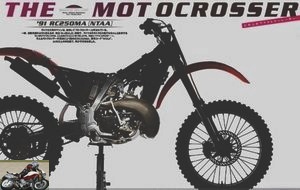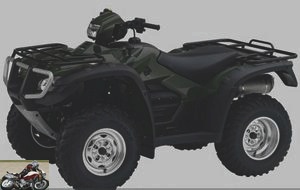Menus
- Comparative test of the 5 Honda models with dual-clutch DCT transmission
- Introduction
- Encouraging review
- How it works ? two independent clutches
- The advantages of DCT
- What changes on the 2012 versions: downgrade manually
- For testing
- Crosstourer vs VFR 1200
- Balance sheet
- Honda and automatic transmission: 50 years of development
- 1962: Juno M85
- 1976: CB750A "Hondamatic"
- 1990: RC250MA
- 2000: TRX500FA
- 2008: DN-01
Comparative test of the 5 Honda models with dual-clutch DCT transmission
Honda has just offered a technical upgrade to its dual-clutch DCT transmission appeared in 2010 and now available on 5 vehicles in its range: VFR 1200, Crosstourer 1200, NC 700S and 700X, Integra, CTX 700. Le Repaire has tested them all, just to see if the automation revolution is (finally) underway ….
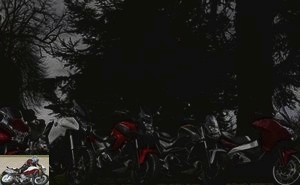
Introduction
When Honda unveiled its dual-clutch transmission in 2010, few observers predicted a great success for this umpteenth attempt by the world’s leading manufacturer to bring the automatic transmission up to date (see box at the bottom of the page). Especially after the commercial failure of the DN-01 with hydromechanical transmission, the production of which was halted barely two years after its commercialization.
It must be said that the world of motorcycles is steeped in traditionalism. Where a motorist has welcomed innovations such as injection, disc brakes or ABS with open arms, the average rider has taken well over two decades to accept the benefits and often reluctantly. Why ? A few historians and a good bunch of marketing graduates are still looking for a rational explanation for this attitude which, with a few Temple Guardians, borders on obscurantism…. The Suzukists have spoken of sacrilege during the abandonment of the air and oil engine, the Ducatists cried foul when the injection appeared, the Guzzists still mourn the gradual disappearance of "two-valve" engines. Even at Honda, the abandonment of the sprocket stunt on the VFR V4 has caused a lot of ink to flow! In short, in the light of these too many examples, the introduction of the DCT seemed courageous, even reckless. And yet ….
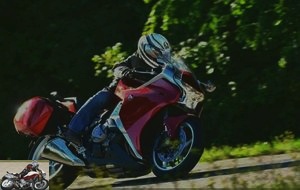
Encouraging review
The first machine equipped with the Honda DCT double clutch transmission was the VFR 1200F in May 2010, a machine supported in early 2012 by the big trail Crosstourer with whom it shares the same V4. Honda then developed its DCT for the 670 cm3 vertical twin fitted to the Integra scooter (2011) then the NC 700 in roadster and trail version (2012). It was also in 2012 that Honda launched a new version of the gearshift management software on the VFR 1200. This upgrade was then extended to the rest of the DCT range and can even be updated on models marketed before this date. Prudent, Honda only marketed its DCT transmission as an option on all its models, except on the Integra, scooter obliges. And it is clear that, after now three full years of marketing, the DCT seems to have found its audience. At the end of February, more than 12,500 DCT models, all versions combined, had been sold in Europe and the proportion of sales of dual-clutch models since the start of the year has increased exponentially. On the NC 700 X, the percentage of DCT stagnated at the end of 2012 below 30% before jumping to more than 40% in February 2013. Ditto for the Crosstourer DCT with more than 70% of sales at the start of 2013 against only 40% at the end 2012. Even at Honda, these growth figures are surprising, exceeding initial forecasts. Not that the world’s leading manufacturer does not have faith in its product, but this famous “technological brake” seems to have disappeared, aided by the great popularity of double clutch gearboxes in the automotive segment (logical, given that more than 90% of motorcyclists also have a car!). Honda also announces that its DCT range will expand in the future, in particular with the arrival at the end of 2013 of the custom CTX 700 on the European market..
How it works ? two independent clutches
The architecture of this system uses two independent clutches, one for even gears (2nd, 4th and 6th), the other for odd (1st, 3rd and 5th).
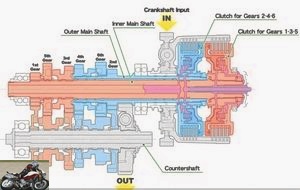
These two clutches work alternately for changing gears. Thus, when one goes up or down a gear, the electronic control unit detects the movement of the control, engages the selected gear then releases the clutch of the first gear while engaging the clutch of the second, making it possible to obtain smooth gear changes. And to change gears, the elbow and calf oil to operate the clutch and selector is replaced by a small electric motor.
DCT transmission offers two operating modes AT (Automatic) and MT (Manual) in order to best respond to the driving style selected by the pilot thanks to the controls located on the right stalk.
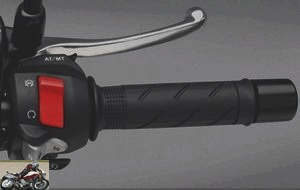
In automatic mode, all gear changes are carried out automatically under the control of a microprocessor equipped with an “intelligent” selection function since it constantly evaluates the behavior of the driver and the machine in order to determine the precise moment when change gear. On the right hand, the pilot can choose between the sub-mode “D” (Drive) to favor softness and consumption or the submode S (Sport) in order to obtain the best possible performance. In manual mode, the pilot uses the controls on the left hand to select gears, up or down gears by using the index finger on the "+" or "-" controls on the stalk.
The advantages of DCT
Technically, this transmission is the ultimate, combining the advantages ofclassic automation (variator or CVT) and a good old manual gearbox.
Faced with the first, a DCT is not only more responsive but also significantly more precise in its management of the dosage of power to the accelerator.
And compared to the second – besides benefiting from an automatic mode – the life of the clutch is increased tenfold by the drastic reduction in friction with each gear change. But all this at a price, whether on the scale (+ 10 kg on average) or on the bill (+ € 1000 against € 1300 in 2010 when the VFR 1200 was launched). On the other hand, the spectacular gains in consumption seen on certain automobiles are not present here. For example, Honda announces for its Crosstourer a consumption of 6 l / 100 km with DCT and 6.2 l / 100 km without.
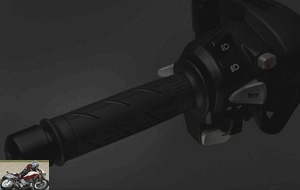
What changes on the 2012 versions: downgrade manually
Improvements made to the DCT transmission in 2012 relate to shift management. Thus, Honda has added to its automatic mode (D or S) the ability to manually downshift gears, especially when approaching a bend to take maximum advantage of the engine braking. In the past, the simple act of downshifting would permanently switch from automatic mode to manual mode, requiring incessant manipulations to switch back to automatic mode as soon as you wanted to fine-tune the engine brake.
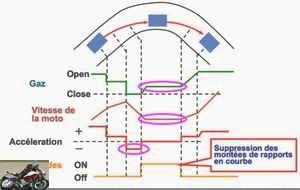
Another change, the automatic D mode has become more “flexible” and is able to react and adapt to the driving style of its pilot, going so far as to flirt with the specific passing laws of the S mode. In addition, the electronics are now able to detect the typical actions of an input curve in order to avoid untimely upshifts. Finally, the V4 models (the only ones to have a ride-by-wire accelerator) are now able to mimic the little throttle that is given during a downshift on a manual transmission, in order to obtain passages faster reports. Honda specifies that these improvements concern only the electronics, it is possible to update the software at the dealership for older models.
For testing
To facilitate reading (and reduce the length of the text), the test of the DCT range focuses on the transmission, its qualities and possible defects.
First of all, it should be noted that in the family powered by the 670 cc vertical twin, each model is not in the same boat. Thus, the Integra is only available with the DCT -scooter transmission and in its most powerful configuration of 51 horsepower. The small NC 700 S roadster is only available in a “European license A2” version (limited to 47 hp.) And can be fitted with a conventional or DCT gearbox. As for the trail version NC 700 X, it is the only model entirely available to order with the two power levels and the two types of transmissions ….
And for the three models, the gain of the update to the 2012 specifications is not only noticeable, but particularly welcome..
Previously, the management of the engine brake in automatic mode had a bit of an ass between two saddles. Not enough D, too much S, to the point that you tended to adjust your driving style to the chosen sub-mode. A shame for an automatic gearbox. Moreover, the old DCT only proved to be a real problem when it was necessary to increase the pace a little. The twin was designed as a pure switching tool with a low rotation speed (the maximum power is at 6,250 rpm) and a very flat torque curve, all to the benefit of consumption (3.6 l / min). 100 km) and ease of handling. That is ! It is also perfect when confined to its role of "displacer". To arouse on the other hand, it is not ecstasy. In manual mode (or with a conventional gearbox), the twin lacks pep and exudes the same sensations at high revs as a turbo diesel: by changing gear, the sound volume changes but the thrust does not vary! Frustrating…. The DCT spec 2012 therefore comes to arrange all that and in a very nice way. From now on, we remain stuck in auto mode and all it takes is a flick to downshift the number of gear chosen, knowing that the transmission will itself go up the gears on re-acceleration or will reset to the “good” report after a short time of latency. Perfect for negotiating a roundabout or a pin, this new DCT also allows (finally?) To ride at a fast-paced pace in D mode where the old management required you to choose between bucolic cruising or MotoGP style. And in a more subjective way, we feel that the electronics manage gearshifts in an infinitely smoother and smarter way than the pilot (or at least the author of these lines), whether it is to wind up smoothly in traffic. or so as not to be late for work. Suffice to say it bluntly, the manual mode is useless here or almost as the automatic management is transparent. In short, smoothness and responsiveness were already there and this version 2.0 dual-clutch transmission now adds flexibility and unparalleled driving pleasure. For those who will be able to afford the cost, the DSG is therefore even more important as a mandatory option.
Crosstourer vs VFR 1200
It’s time to test the Crosstourer and VFR 1200 F duo.
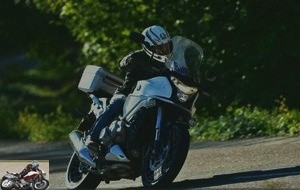
On the Sport GT, the larger size and generous weight of the machine (almost 290 kg) requires a little longer adaptation time to the DCT despite the legendary ease of handling the brand’s machines. Once the Pavlovian reflex of looking for the clutch lever has been curbed during changes at very low speed (U-turns, maneuvers, etc.), we realize that the management of slip in first gear is, if not perfect, at least very easy. to apprehend for a neophyte. And after several tens of kilometers, operating the multiple triggers and buttons of the DCT becomes child’s play. As on the 700, the possibility in automatic mode to “take control” to downshift manually offers a real gain in approval, much helped by the famous automatic gas stroke which smoothes overflows of the engine brake. Another reason for satisfaction with this new generation DCT is the "detection of typical actions when entering a curve" which prevents unwanted upshifts on the angle when the engine brake is needed most..
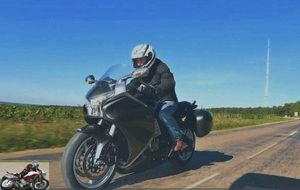
The advantage of the system is less over the 700 cc due to their lower weight and power, but it really makes sense with a machine with a gross vehicle weight of 463 kg! On the other hand, the laws of shifting of gears on the VFR 1200 DCT seem less successful than its little sisters. Soft and smooth most of the time, the Honda double clutch reveals jerks when changing gear at full load. Blame it on our French bridle which amputates the beauty of almost 70 horsepower. On the Crosstourer, on the other hand, which does “only” 129 horsepower in the free version, the phenomenon is almost imperceptible. We “feel” that the clutches are working too fast, anticipating a more brutal thrust than the sad reality…. A fault that will resolve itself in 2016 when France finally joins the free world. But in restricted version, the VFR suffers from the direct comparison with the Crosstourer. Admittedly, the VFR was also reworked in 2012 to offer more torque at mid-range, but the Crosstourer version of the V4 is definitely rounder and more pleasant to use in the context of strict touring use. As a result, the pilot will tend to use the DCT differently on the two machines. On motorways and in urban areas, the D auto mode imposes itself as its softness works wonders. On departmental roads, the VFR requires driving in S mode to take full advantage of the engine’s performance or to switch to Manual. On the Crosstourer, the low-end torque combined with the extended functions of D mode means that you rarely feel the need to switch to S and Manual mode..
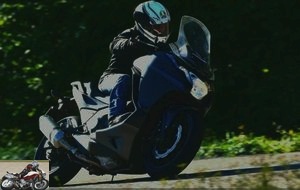
Balance sheet
At the end of this (very) long day of testing this "new" DCT range, we can now say that this technology is sufficiently mature to seriously compete with manual transmissions. To the ease of driving, typical of automatic transmissions, Honda adds a management of the engine brake sufficiently fine and intelligent to provide real driving pleasure, at least on the V4 versions. Suddenly, it is a real alternative to those who want a real motorcycle but no longer want to bother with gearshifts, especially in urban and para-urban use. Admittedly, the DCT entails an additional cost of 1000 €, which some will consider prohibitive and can still be fine-tuned on a few points. First, the downshift between second and first is always a bit abrupt, a detail already formulated on the first models. Second, the DCT does not register multiple gear change commands, including downshifting, although the new features make you want to overdo it. It is therefore imperative to break it down, because two pulses too close together on one of the triggers and the DCT will only change one speed. On the other hand, the system protects motorcyclists with the trigger too easy and wanting to go too fast. Finally, the Honda system does not – for the moment – offer such meteoric shift speeds as some cars and we are far from the 0.060 seconds of a Ferrari 458 (admittedly not at the same price). But the Honda DCT has evolved well without forgetting that the world number one also has other assets up its sleeve, starting with its in-house HFT automatic transmission that it has been refining for 50 years (see box below) as well as its famous gearbox. seamless on MotoGP RRS. In short, Honda seems to see the future in automatic !
Honda and automatic transmission: 50 years of development
1962: Juno M85
Countless models of scooters are appearing on the market, most of them manufactured by European manufacturers familiar with this type of practical and accessible vehicle. On the Japanese side, Honda is not left out with the launch, in July 1962, of the Juno M85, the second scooter signed by Honda after the 1954 Juno K. Original and innovative, ignoring any convention – as is often the case with Honda -, the Juno is powered by a 170cc 4-stroke flat-twin placed just behind the front wheel. In addition to its hydraulically controlled valves, this engine is characterized by an automatic hydraulic transmission type "Badarini" (HMT), a principle which will be taken again half a century later on the DN-01. In the absence of any electronic management (we are still in the 1960s), this continuously variable transmission is operated manually. The system is designed so that the left hand is dedicated to the management of the variation while the right hand is reserved for that of the throttle. Technically, the Juno’s transmission is a combination of a constant volume hydraulic pump and a variable volume hydraulic motor. Completed by a hydraulic clutch allowing manual variation of the applied pressure, the system allows manual operation as well as automatic starts..
1976: CB750A "Hondamatic"
In 1976, building on the popular success of the CB750 Four, Honda launched a new model in the US market primarily aimed at women and beginners with an automotive background: the CB750A0 (A stands for "Automatic"). Based on the 4-cylinder of the CB750 Four, engineers from the CIVC AT Design Group have developed new crankcases that contain a two-speed automatic transmission associated with a hydraulic torque converter. Although dubbed "Hondamatic" like the one found in some Honda cars of the time, especially the N360 released in Japan between 1967 and 1972, this transmission was not fully automatic. Indeed, each of the two gears must be engaged by the pilot thanks to a selector which controls the circulation of high pressure oil in each clutch (the CB has a relative clutch) and allows the engagement of the report in question. Commercial success will unfortunately not be there. It says that the transplant of a converter consumed almost 10 horsepower and the total absence of engine braking made it a giant moped, all with the limited braking of the machines of the time …. The CB750A disappeared from the Honda catalog in 1978. In the years that followed, other smaller displacement models took up the concept of the "Hondamatic" transmission such as the CB400A (1978) and CM400A (1980) or the CM450A (1982).
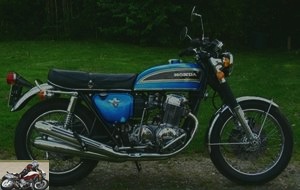
1990: RC250MA
Officially entered in the Japanese Motocross Championship in 1990 and 1991, the RC250MA will cause a sensation with a revolutionary aluminum frame and many other alloy components to keep weight down. The RC250MA is above all the first cross-country bike (and the only one to date?) To use a hydromechanical automatic transmission. Technically, although inspired by that used on the Juno (type HRD), the HFT transmission developed for the RC250MA is characterized by a pump working on a common shaft with the motor. At the end of the 1991 season, after two years of development and fine-tuning under the most demanding conditions, the HFT automatic transmission confirmed its potential by allowing Takayuki Miyauchi to win the 1991 MX Japan Championship..
2000: TRX500FA
It was in 2000 that the principle of the HFT transmission was applied to a production model, in this case the TRX500FA "Fourtrax". The system allows idling while preserving the "feel" of the pilot thanks to the engine braking, unlike the automatic transmissions of the time. Occasionally the transmission is Hondamatic. Today, most utility quads in the Honda range have this technology..
2008: DN-01
At the end of 2005, at the Tokyo Motor Show, Honda presented the DN-01 concept, a model that surprises as much by its forms as by the technology it contains. Illustrating Honda’s desire to develop a different 2-wheel concept capable of responding to the emergence of a new clientele, the DN-01 appears halfway between a motorcycle, from which it takes on the general appearance and dynamic behavior. (as well as the absence of a blade under the saddle) and a scooter for certain aspects such as the automatic transmission. At that time, confused by the look for the less original of the DN-01 as well as its relatively high price, few are those who believe in the realization of this concept. Two years later, the marketing of the DN-01 was announced and with it the development of a new generation automatic transmission associated with the Deauville 680cc V-twin. Extrapolated from HMT technology but developed in the same spirit as that of the RC250MA fifteen years previously (to match its operation to the needs and intentions of the pilot), the new generation transmission that equips the DN-01 uses the terminology "Human-Friendly Transmission" (HFT). Clutch-free, easy to use and leaving room for a certain sportiness in its operation, the HFT transmission is a continuously variable hydromechanical assembly which is distinguished by its extreme compactness, to the point of being able to be combined with existing engines without major modifications. . The mechanical assembly made up of the HFT system in fact concentrates the functions of starting, power transmission and gear variation, all gathered around a single shaft. Without the clutch and gearbox in their conventional form, the HFT unit is completely independent, with the exception of the Neutral / Drive selection mechanism. Unfortunately, there too the success will not be there and the DN-01 will not remain in the Honda catalog until between 2008 and 2011. But unlike the Hondamatic, the quality of the transmission is not in question. The reasons for its failure on the market are more to be found on the side of its premium price (almost 12,000 euros), little in relation to its V2 with common origins (the first versions fitted the NTV 650) and too modest performance ….
Strong points
- ease
- competes with manual transmissions
- engine brake management
Weak points
- additional cost of 1,000 euros
Related articles
-
Honda VFR 1200 DCT Automatic Test
The automatic soul Disappointing in a traditional gearbox, it seems that the VFR 1200 with double clutch takes all its measure with the automatic…
-
The migratory meaning The spirit of adventure certainly blows through the 2012 motorcycle production. Indeed, no less than three new maxi-trails come to…
-
Comparative test DN 01, XL700V Transalp ABS-CBS, NT700V Deauville ABS CBS What can lead to compare 3 motorcycles as different as a DN 01, an XL700V…
-
Honda CMX 500 Rebel S motorcycle test
Little rebellious bobber In-line twin, 471 cm3, 45 hp at 8,500 rpm, 44.6 Nm at 6,000 rpm, 190 kilos, € 6,299 Rather bi or 4? It’s that the couple is…
-
The legacy motorcycle of Tron and Akira Is it characteristic of a great manufacturer to dare to even go beyond innovating? In any case, Honda succeeded…
-
The roadster in its travel livery and double clutch Good at everything Honda brought to motorcycles the concept developed in the automobile in the 90s:…
-
Honda VFR1200X Crosstourer DCT test
129 hp at 7,750 rpm, 12.8 m / kg at 6,500 rpm, 289 kilos with full tank, € 15,899 A big road trail with double clutch gearbox for a new way of riding…
-
Honda NC 700 X motorcycle test
Transgenic camel Discovered at the Milan Motor Show, the Honda range is enriched with a new range of 3 midsize machines, available on the same chassis…
-
Honda Forza 750 maxi-scooter test
GT sport scooter Twin cylinder of 745 cm3, 58.5 hp, 69 Nm, 11,649 euros A page is turning for Honda scooters in 2021! Who remembers the SWTs, the…
-
The Japanese endurance Bimota based on Honda CBR900RR Fireblade 4 cylinders in line, 944 cm3, 177 hp, 163 kg TSR Honda AC90M. Who does this name mean?…

